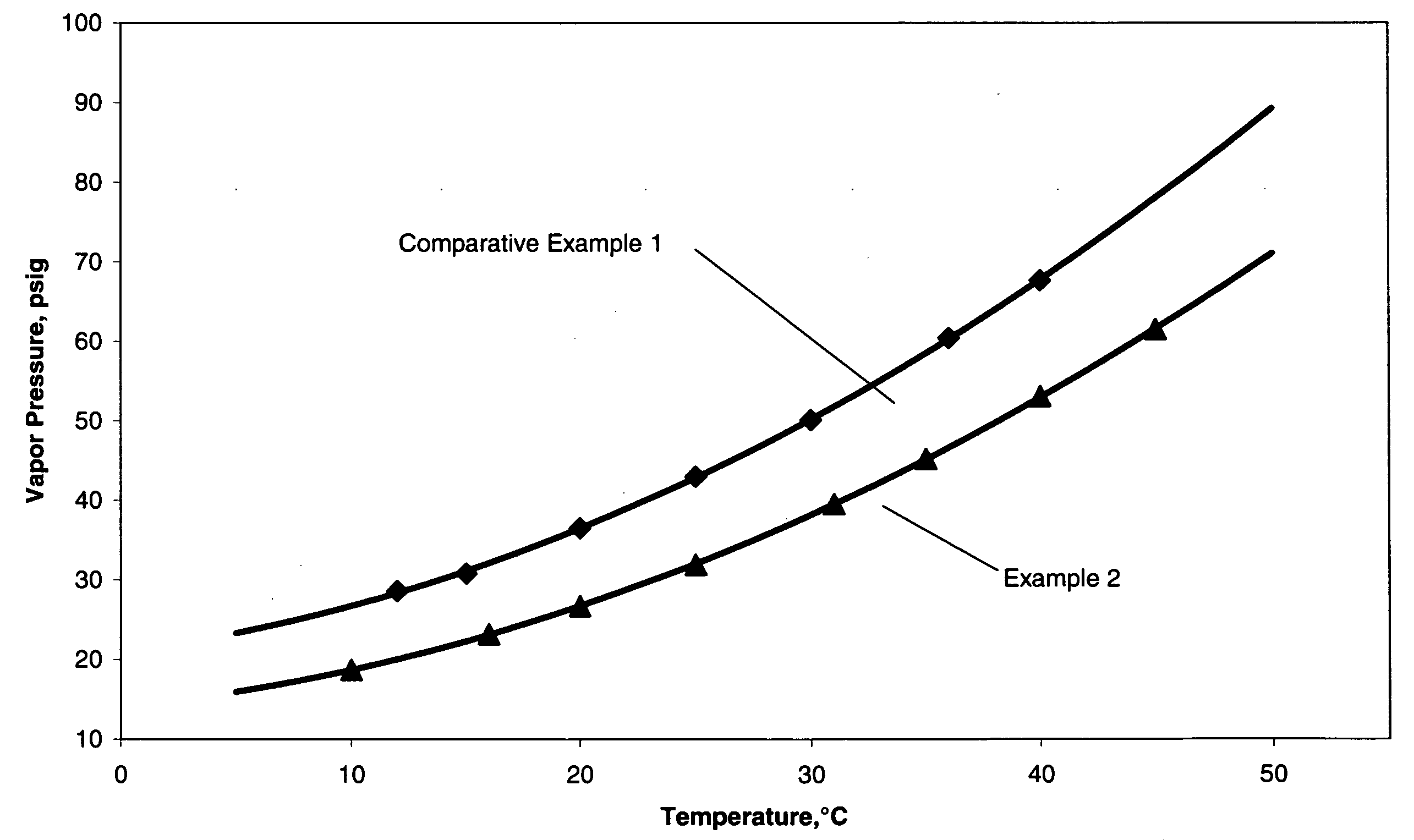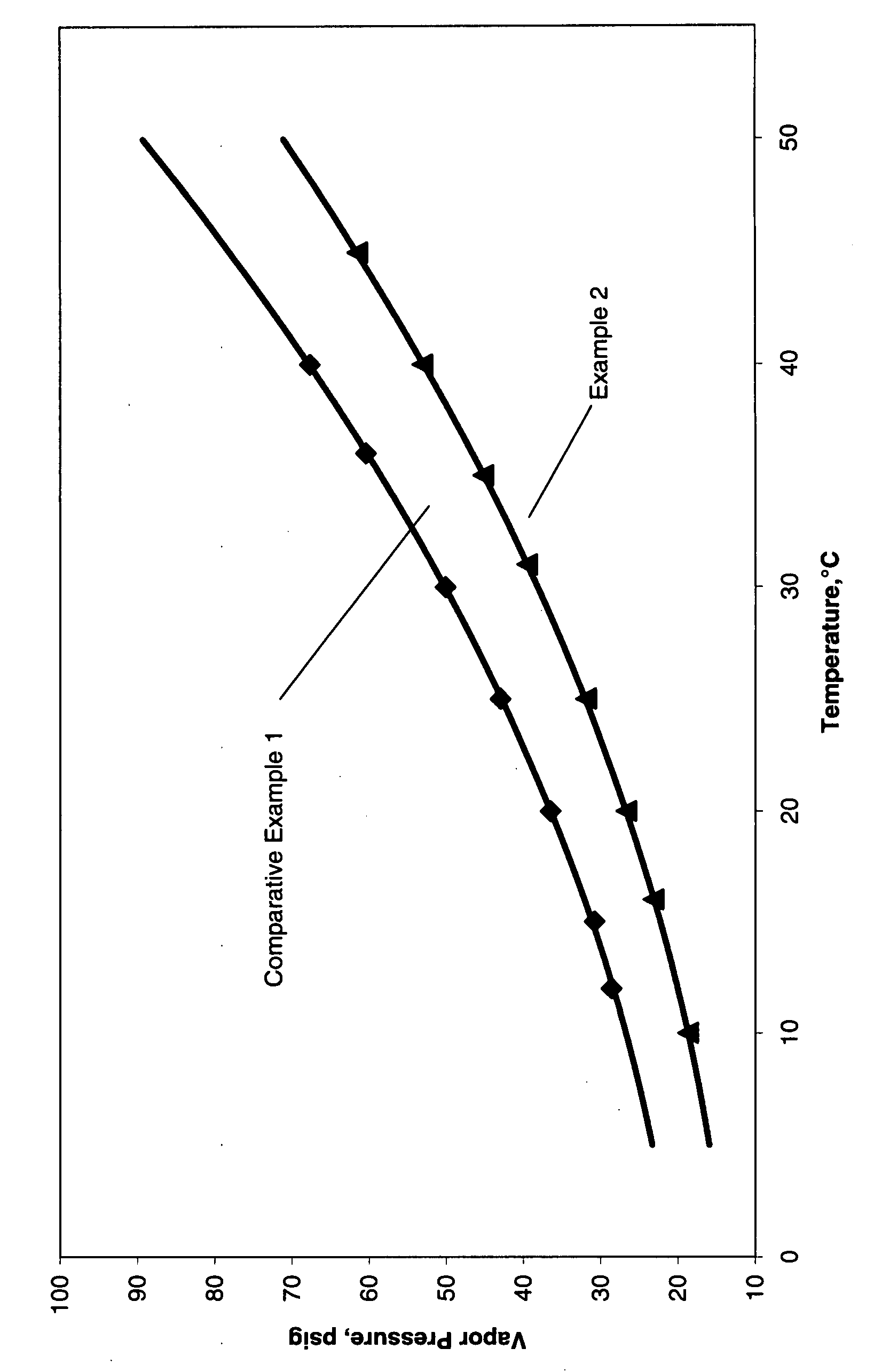Foam-forming system with reduced vapor pressure
- Summary
- Abstract
- Description
- Claims
- Application Information
AI Technical Summary
Benefits of technology
Problems solved by technology
Method used
Image
Examples
examples 1-2
[0059]POLYOL A, PC and SOL A, each used in the amount listed in Table 1, were blended and 400 g of this blend were placed into a 600 ml Parr pressure vessel equipped with an agitator and a pressure gauge. The sealed vessel was then weighed and purged with HFC-134a by repeatedly pressurizing to 50 psig and venting to ensure that all of the air had been removed from the head space. 49.4 g of HFC-134a were then added to prepare a blend containing 1 1% HFC-134a (minus the amount of blowing agent in the head space).
TABLE 1Example1*2POLYOL A400320(g)PC (g)—40SOL A (g)—40HFC-134a49.449.4*Comparative Example
[0060]The blend containing HFC-134a was then cooled to below 10° C. and allowed to equilibrate while agitating. This blend was then slowly warmed and the vapor pressure and temperature were periodically recorded.
[0061]The pressure versus temperature curves for these blends are shown in FIG. 1. This graph clearly shows that the combination of propylene carbonate and ethoxylated nonylpheno...
examples 3-8
Examples 3 - 8
[0062]HFC-134a was bubbled into a vessel containing a blend composed of the materials listed in Table 2 in the amounts listed in Table 2 at ambient temperature and a pressure of approximately 730 mm Hg. The amount of HFC-134a absorbed is reported in Table 2. 100 parts of the HFC-134a containing formulations described in Table 2 were hand mixed with the given amount of NCO for 10 seconds before pouring into a box to form a polyurethane foam. The foam properties are reported in Table 2 for those blends which could be hand mixed. The desired amount of HFC 134a could not be added in comparative Example 3.
TABLE 2Example3*45678Polyol B (pbw)30.6123.3221.0020.00—31.06Polyol C (pbw)29.6622.6025.0023.00——Polyol D (pbw)23.7318.0820.0018.00——Polyol E (pbw)————47.44—Polyol F (pbw)————20.32—Polyol G (pbw)—————15.52Polyol A (pbw)—————15.52SOL A (pbw)—10.0010.0010.0010.9010.00PC (pbw)—10.008.008.005.0011.00B-8484 (pbw)2.202.20————B-8465 (pbw)——2.202.201.732.50PC-8 (pbw)0.800.800.800....
example 9
[0063]In this example, the formulation from Example 5 was foamed on a Hennecke HK-100 high pressure foam machine equipped with a Hennecke MQ-12 mix head. The polyol and isocyanate temperatures were both controlled at 70° F. and the total liquid throughput was adjusted to 57.5 lb / minute. The pre-foam mixture was injected into a vertical panel mold measuring 5 cm thick×20 cm wide×200 cm high and allowed to react. The key foam properties obtained from these panels are presented in Table 3.
TABLE 3Example9Minimum Fill Density, lb / ft32.24Packed density, lb / ft32.34Average Core Density, lb / ft32.12Parallel Compressive Strength, lb / in230.83Perpendicular Compressive Strength, lb / in220.57Closed Cells, %86.4k-Factor at 75° F., BTU-in / hr-ft2-° F.0.162
PUM
| Property | Measurement | Unit |
|---|---|---|
| Percent by mass | aaaaa | aaaaa |
| Percent by mass | aaaaa | aaaaa |
| Percent by mass | aaaaa | aaaaa |
Abstract
Description
Claims
Application Information
 Login to View More
Login to View More - R&D
- Intellectual Property
- Life Sciences
- Materials
- Tech Scout
- Unparalleled Data Quality
- Higher Quality Content
- 60% Fewer Hallucinations
Browse by: Latest US Patents, China's latest patents, Technical Efficacy Thesaurus, Application Domain, Technology Topic, Popular Technical Reports.
© 2025 PatSnap. All rights reserved.Legal|Privacy policy|Modern Slavery Act Transparency Statement|Sitemap|About US| Contact US: help@patsnap.com


